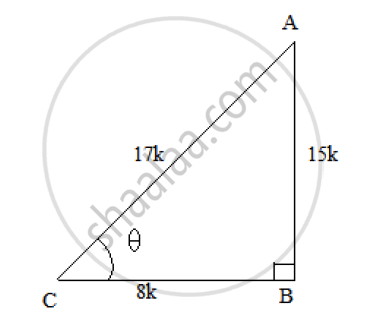Advertisements
Advertisements
Question
If sec `theta = 17/8 ` verify that `((3-4sin^2theta)/(4 cos^2theta -3))=((3-tan^2theta)/(1-tan^2theta))`
Solution
It is given that sec 𝜃`=17/8`
Let us consider a right ΔABC right angled at B and ∠𝐶 = 𝜃
We know that cos 𝜃 =`1/sectheta = 8/17 =(BC)/(AC)`

So, if BC = 8k, then AC = 17k, where k is a positive number.
Using Pythagoras theorem, we have:
`AC^2 = AB^2 + BC^2`
`⟹ AB^2 = AC^2 − BC^2 = (17K)^2 − (8K)^2`
`⟹ AB^2 = 289K^2 − 64K^2 = 225K^2`
⟹AB = 15k.
Now, tan 𝜃 =`(AB)/(BC) =15/8 and sin theta =(AB)/(AC) =(15K)/(17K)=15/17`
The given expression is `(3-4 sin^2theta)/(4cos^2 theta-3) = (3-tan^2theta)/(1-3tan^2theta)`
Substituting the values in the above expression, we get:
LHS=`(3-4(15/17)^2)/(4(8/17)^2-3)`
=`(3-(900/289))/((250/289)-3)`
=`(867-900)/(256-867)=-33/-611 =33/611`
RHS = `(3-(15/8)^2)/(1-3(15/8)^2)`
= `(3-225/64)/(1-675/64)`
= `(192-255)/(64-675)=-33/-611 = 33/611`
∴ LHS = RHS
Hence proved.
APPEARS IN
RELATED QUESTIONS
If 8 tan A = 15, find sin A – cos A.
If 3tan θ 4 , show that `((4cos theta - sin theta ))/((4 cos theta + sin theta))=4/5`
If sin ∝ = `1/2` prove that (3cos∝ - `4cos^2` ∝)=0
If sin (A + B) = 1 and cos (A – B) = 1, 00 ≤ (A + B) ≤ 900 and A > B, then find A and B.
Given: tan A = `4/3 , "find" : ("cosec""A")/(cot "A"– sec "A")`
If cos A = `(1)/(2)` and sin B = `(1)/(sqrt2)`, find the value of: `(tan"A" – tan"B")/(1+tan"A" tan"B")`.
Are angles A and B from the same triangle? Explain.
If cosec θ = `sqrt5`, find the value of:
- 2 - sin2 θ - cos2 θ
- 2 + `1/sin^2"θ" – cos^2"θ"/sin^2"θ"`
From the following figure, find:
(i) y
(ii) sin x°
(iii) (sec x° - tan x°) (sec x° + tan x°)

If cos A = `3/5`, then find the value of `(sin"A" - cos"A")/(2tan"A")`
If sin θ = `"a"/sqrt("a"^2 + "b"^2)`, then show that b sin θ = a cos θ
